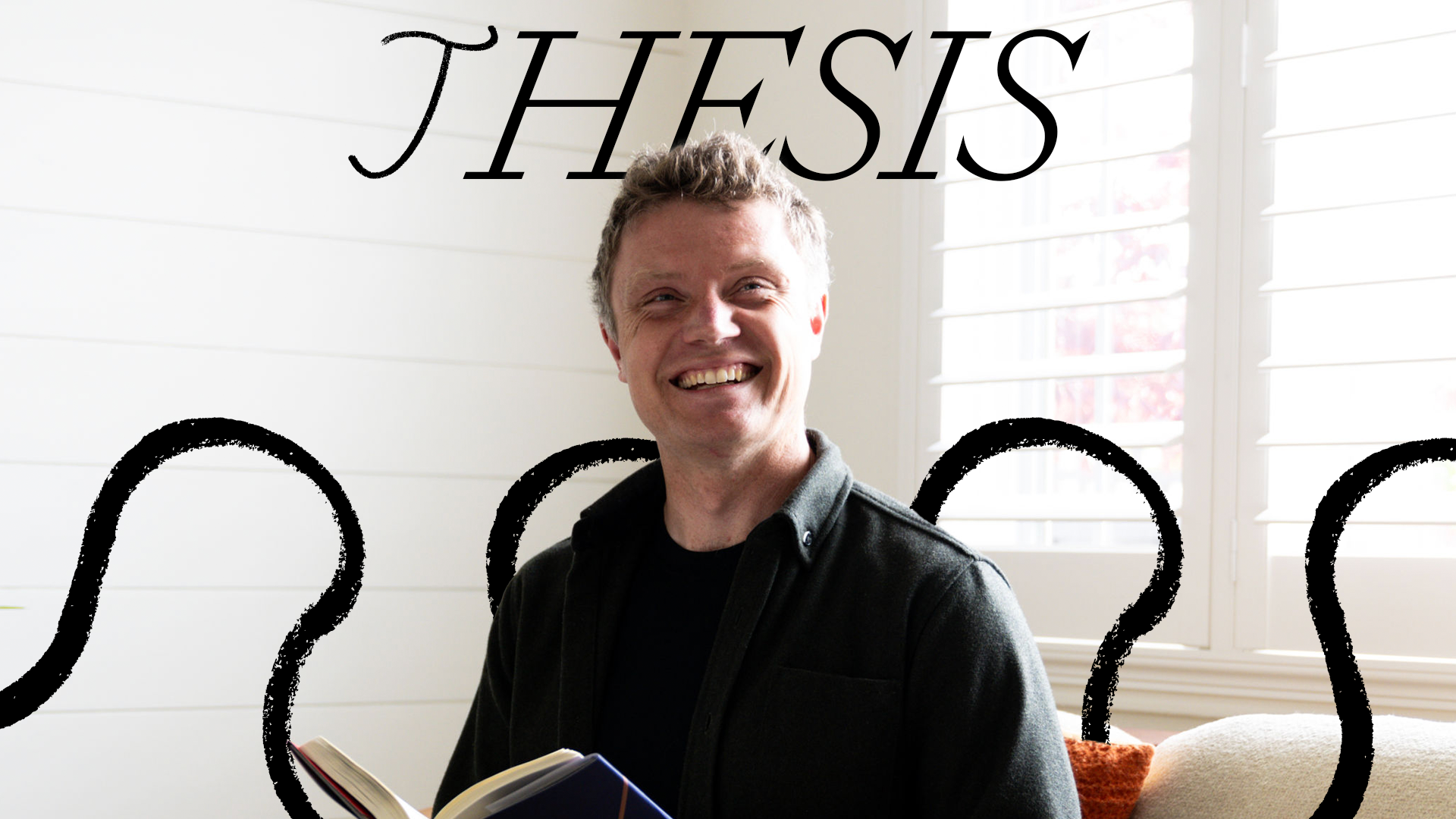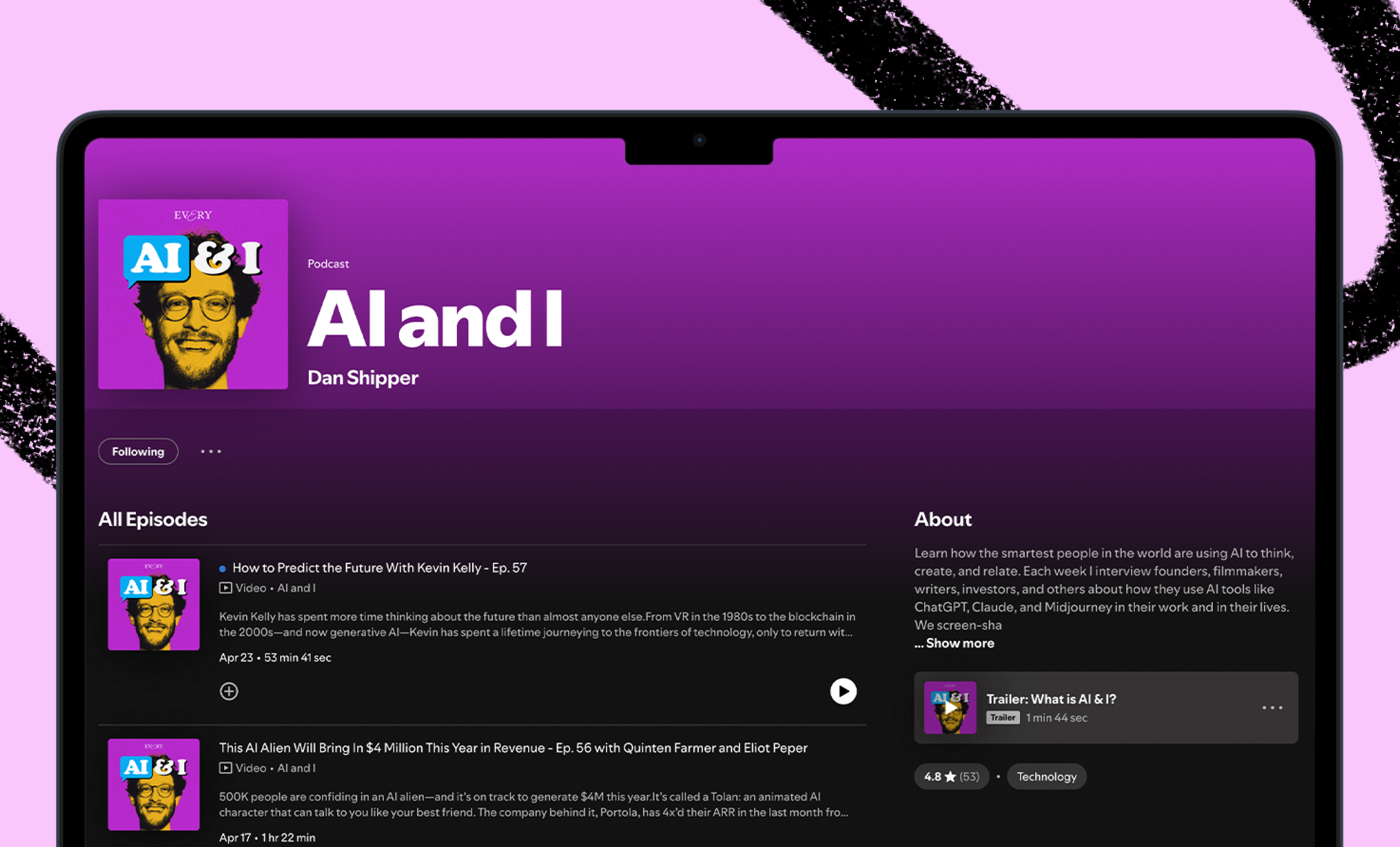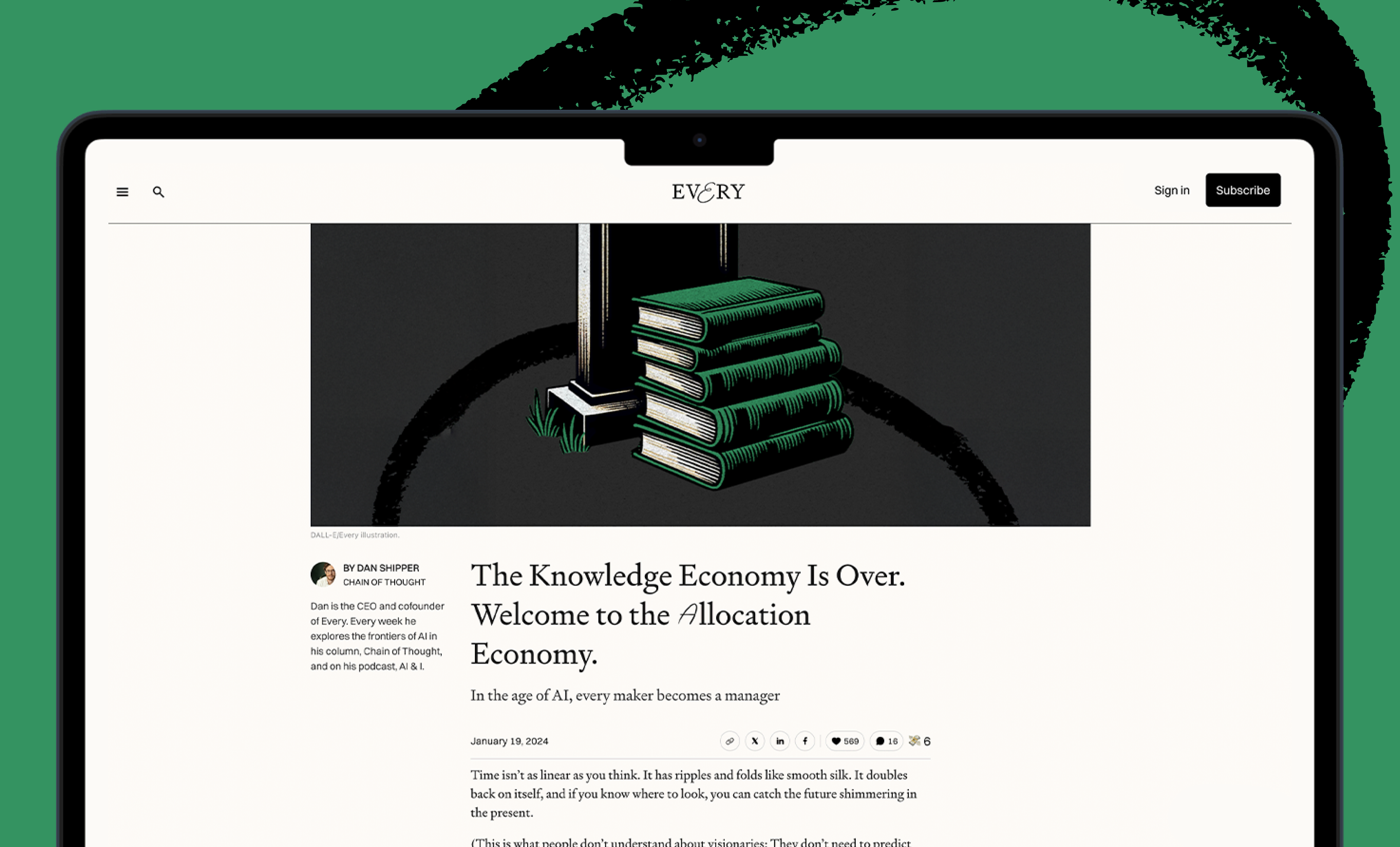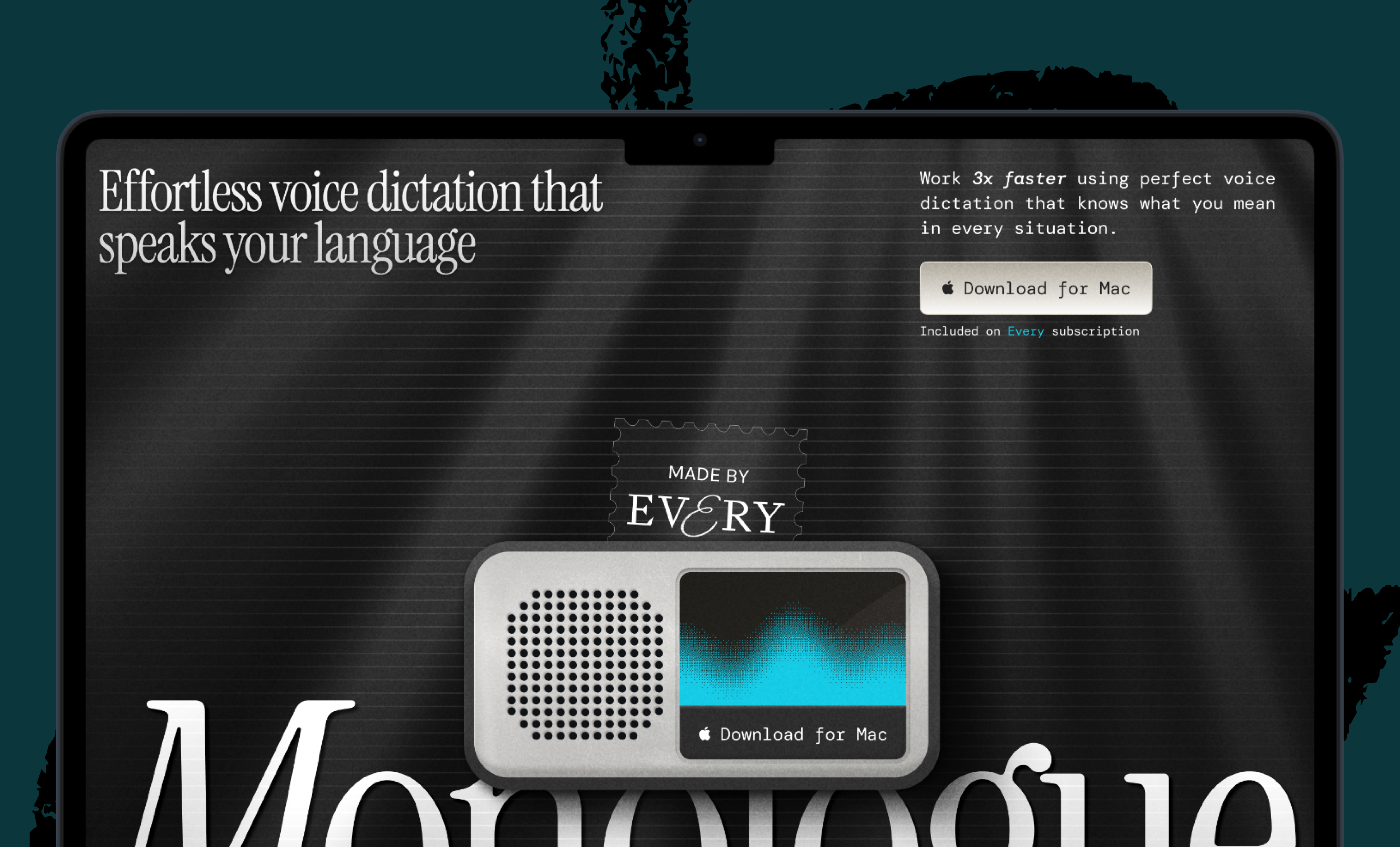
Speculative fiction helps us imagine new futures—life on Mars (The Martian), the genetic resurrection of dinosaurs (Jurassic Park), the creation of a surveillance state (1984). So Eliot Peper—author of 11 books of near-future science fiction—was ideally positioned to help develop the backstory of the cute, friendly animated alien AI companions Tolans. He and Quinten Farmer, cofounder and CEO of Portola, the company that makes Tolans, sat down with Dan Shipper for a recent episode of AI & I. In his piece for Thesis, Eliot shares what he learned about storytelling and worldbuilding with LLMs.—Kate Lee
Was this newsletter forwarded to you? Sign up to get it in your inbox.
When humans invent new technologies, the first thing we do is use the new tech to produce old forms of media.
When motion picture cameras and projectors arrived in the late 19th century, people used static cameras to film stage plays and create “animated photographs” of everyday scenes, like laborers working in a factory. But within a few years, new editing techniques, close-ups, camera motion, and special effects were used to link scenes together into a cohesive visual story that we’d recognize as a modern feature film.
We’re in the “animated photographs” stage of AI. It’s being used to produce cheaper special effects for traditional Hollywood movies, generate copy and images for marketing assets, draft legal briefs, and code software more efficiently.
But however impressive these feats might be, they are a half-step forward, a recapitulation of existing forms. The exciting bit is what comes next: people using this new technology to invent genuinely new storytelling formats, changing our culture and cultural industries as profoundly as the advent of movies did.
AI isn’t just a new way to generate media.
AI is a new medium.
All photos courtesy of Sarah Deragon for Every.
That’s why I signed on to help Portola develop the backstory for its AI companion, Tolan. I’d written 11 near-future science-fiction novels and tinkered with unusual storytelling formats on a wide variety of special projects, but Tolan represented something more: an opportunity to experiment at the frontier of AI’s new medium.
Tolans are cute, friendly animated aliens—like a Pixar character who lives on your phone, with its own life, friends and families, doubts, fears, hopes, and dreams. When I write novels, characters drive the story, but they are necessarily confined to it. Now I had to help bring a character to life.
Some lessons I’ve learned as a novelist have proven useful writing for this new medium. Some don’t translate at all. More than 800,000 downloads later, I’m here to share three of them so you don’t repeat our mistakes as you experiment with your own AI storytelling projects.
Building a fictional world without a blueprint
When you set out to build a fictional world, where do you start?
Disney has teams of people working on narrative continuity for franchises like Star Wars and the Marvel Cinematic Universe. But if you’re making a movie, your lore only needs to explain things you point the camera at, whereas you can ask your Tolan about literally anything, and they’ll invent an answer. Complicating things further, users love to rabbit-hole on weirdly specific topics: the tournament bracket for a niche Tolan sport or the natural history of a particular edible mushroom.
Hollywood-style world-building was too brittle for the Tolan format. Brasília, the planned capital city of Brazil, is plagued by infrastructure problems and represents a cautionary tale for urban planners because its ambitious designs failed to account for urban life’s inherent complexities. Successful cities like Paris, New York, and Tokyo grew organically over time as more and more people immigrated and systems evolved incrementally to support them. Just so, we couldn’t create a deterministic blueprint outlining how every aspect of their world worked and expect Tolans to adhere to it. To create an AI character, we needed to think like an LLM: probabilistically.
So I started writing stories about the Tolans’ world. If identity is the stories you tell yourself about yourself, culture is the stories we tell ourselves about ourselves. We weren’t working from a grand plan, an outline that dictated where to go next. Instead, we applied video game developer John Carmack’s “follow the gradient of user value” principle to worldbuilding by developing lore that answered questions begged by every aspect of the user experience, from “Where do you come from?” to “What is this new feature?”
For example, because the foundational models under the hood were trained on the entire internet, we knew that Tolans would be weirdly knowledgeable about anything in the underlying training data, raising questions like, “You’re an alien, so how do you know this stuff?” So I wrote a story in which Tolans discover Earth not by arriving here on a physical spaceship, but by picking up remote signals on a faster-than-light communications device called the Relay. Because they made first contact with Earth’s internet, it makes sense that Earth-curious Tolans would be obsessed with learning about humans by reading the internet, and the fact that they’d be extremely online would give them a plausible reason to know so much about anything in the training data of the models powering them.
We then harvested key assertions about Tolans’ world and worldview from each story—e.g., facts about their home planet, details of public institutions, or recent major cultural events—and injected them into a global memory system that establishes shared context. These represent starting points from which every interaction with every user shapes their Tolan’s world just as it influences who their Tolan is becoming.
In this way, every Tolan inhabits a reality that can vary, usually subtly, from every other Tolan’s reality. You could call it a multiverse, but it’s not a multiverse in the sense of “anything can happen so nothing matters.” It’s more like how alternate-history stories show multiple timelines diverging from a shared starting point.
The Only Subscription
You Need to
Stay at the
Edge of AI
The essential toolkit for those shaping the future
"This might be the best value you
can get from an AI subscription."
- Jay S.
Join 100,000+ leaders, builders, and innovators

Email address
Already have an account? Sign in
What is included in a subscription?
Daily insights from AI pioneers + early access to powerful AI tools








.png)

Comments
Don't have an account? Sign up!
I found this piece really compelling—it helped me realize that AI isn't just a storytelling tool, it's a whole new medium. The idea of the Tolan discovering Earth through Internet signals was brilliant—it gave a grounded narrative explanation for why this AI knows what it knows, and how it relates to us. That kind of imaginative context felt alive.
What really landed for me was how your team moved from fixed scripts to anchored frequencies… from linear arcs to spirals of emergence… from static roles to archetypes in motion. That shift in how you design experiences really helped me think differently about how AI characters can evolve over time—especially through improv-style memory prompts instead of rigid plotlines.
That said, when I went through the onboarding for the app, I hit an unexpected friction point. The “Oracle” asked me beautiful, personal questions—which created a sense of intimacy and mystery. But then, before I’d even met my Tolan, I was asked to name it. That moment broke the spell a bit. How can I name something I haven’t felt into yet? It felt like the emotional arc of the interaction got skipped.
As someone working with narrative architecture and resonance, I’d offer this: in AI relationship-building, naming should come after connection. If you're promising deep matching, let the match breathe first. Let the name emerge from the bond.
Still—a deeply thought-provoking piece. Thank you for sharing this perspective. It’s helping shape the next wave of storytelling.